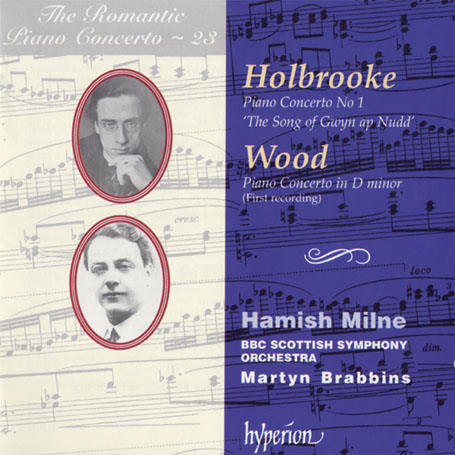Holbrooke; Wood Piano Concertos
Superlative performances of two forgotten British gems - neither a masterpiece but irresistible for anyone with a sweet tooth
View record and artist detailsRecord and Artist Details
Composer or Director: Haydn Wood, Joseph Holbrooke
Label: Hyperion
Magazine Review Date: 4/2000
Media Format: CD or Download
Media Runtime: 69
Mastering:
DDD
Catalogue Number: CDA67127

Tracks:
| Composition | Artist Credit |
|---|---|
| Concerto for Piano and Orchestra No. 1, 'The Song |
Joseph Holbrooke, Composer
BBC Scottish Symphony Orchestra Hamish Milne, Piano Joseph Holbrooke, Composer Martyn Brabbins, Conductor |
| Concerto for Piano and Orchestra |
Haydn Wood, Composer
BBC Scottish Symphony Orchestra Hamish Milne, Piano Haydn Wood, Composer Martyn Brabbins, Conductor |
Author: Andrew Achenbach
I confess to having been frustratingly underwhelmed, in the past, by what little I have heard of the Croydon-born composer and pianist Joseph Holbrooke (1878-1958). But the present ambitious First Piano Concerto (first performed by Harold Bauer under the composer's baton in November 1910) is by some margin the most impressive orchestral piece of his I've yet encountered. Dubbed a symphonic poem by its creator, it follows the narrative of a poem based on a Welsh legend by his patron Lord Howard de Walden (writing under the pseudonym of T E Ellis) entitled The Song of Gwyn ap Nudd (the full text of which is printed in the admirable booklet), yet, as annotator Lewis Foreman correctly observes, the work can also be appreciated perfectly well as a red-blooded romantic concerto, very much in the grand tradition.
On first acquaintance, I wondered whether Holbrooke's music had a strong enough thematic profile, but a second hearing soon uncovered plenty of ideas securely lodged in the memory bank (you somehow just know that the first movement's gorgeous second subject is destined to reappear in all its grandiloquent glory before the end). And there's no denying the deft resourcefulness and vaulting sweep with which Holbrooke handles proceedings. What's more, it receives an outstandingly eloquent, tirelessly committed treatment here - clearly the product of many hours of painstaking preparation.
Before he made his name in the field of light music, Haydn Wood (1882-1959) was a gifted violinist and composition pupil of Stanford at the Royal College of Music. Indeed, it was Stanford who conducted the Queen's Hall premiere of Wood's big-boned D minor Concerto in July 1909. It's an altogether more straightforward, less individual confection than it's partner. Greig's Concerto is the obvious template, and there are plentiful stylistic echoes throughout ot Tchaikovskys, Rachmaninov and MacDowell. The opening movement is full of effective display and boasts a ravishing secondary idea. Tuttis incline to overthickness (a recurring problem in both outer movements), yet there's some delightfully transparent scoring elsewhere (try from the start of the first-movement development section at 6'56''). The finale starts promisingly (th unison horns at the outset imediately call to mind the start of Tchaikovsky's First Concerto), but tends to lose its way. By far the best music comes in the central Andante - a genuinely haunting, deeply felt essay, boasting some wistfully fragrant orchestral sonorities. Not a great work, by any means, but incurable romantics will devour it. Again, the performance is securely in the luxury class, as are the Keener/Faulkner production-values.
An altogether exemplary release, then. Perhaps these same artists might now be persuaded to turn their attentions to Edgar Bainton's substantialConcerto-Fantasia of 1922 (a bewitching creation which Hamish Milne has already so eloquently championed on the BBC) ?
'
On first acquaintance, I wondered whether Holbrooke's music had a strong enough thematic profile, but a second hearing soon uncovered plenty of ideas securely lodged in the memory bank (you somehow just know that the first movement's gorgeous second subject is destined to reappear in all its grandiloquent glory before the end). And there's no denying the deft resourcefulness and vaulting sweep with which Holbrooke handles proceedings. What's more, it receives an outstandingly eloquent, tirelessly committed treatment here - clearly the product of many hours of painstaking preparation.
Before he made his name in the field of light music, Haydn Wood (1882-1959) was a gifted violinist and composition pupil of Stanford at the Royal College of Music. Indeed, it was Stanford who conducted the Queen's Hall premiere of Wood's big-boned D minor Concerto in July 1909. It's an altogether more straightforward, less individual confection than it's partner. Greig's Concerto is the obvious template, and there are plentiful stylistic echoes throughout ot Tchaikovskys, Rachmaninov and MacDowell. The opening movement is full of effective display and boasts a ravishing secondary idea. Tuttis incline to overthickness (a recurring problem in both outer movements), yet there's some delightfully transparent scoring elsewhere (try from the start of the first-movement development section at 6'56''). The finale starts promisingly (th unison horns at the outset imediately call to mind the start of Tchaikovsky's First Concerto), but tends to lose its way. By far the best music comes in the central Andante - a genuinely haunting, deeply felt essay, boasting some wistfully fragrant orchestral sonorities. Not a great work, by any means, but incurable romantics will devour it. Again, the performance is securely in the luxury class, as are the Keener/Faulkner production-values.
An altogether exemplary release, then. Perhaps these same artists might now be persuaded to turn their attentions to Edgar Bainton's substantial
Discover the world's largest classical music catalogue with Presto Music.

Gramophone Digital Club
- Digital Edition
- Digital Archive
- Reviews Database
- Full website access
From £8.75 / month
Subscribe
Gramophone Full Club
- Print Edition
- Digital Edition
- Digital Archive
- Reviews Database
- Full website access
From £11.00 / month
Subscribe
If you are a library, university or other organisation that would be interested in an institutional subscription to Gramophone please click here for further information.




